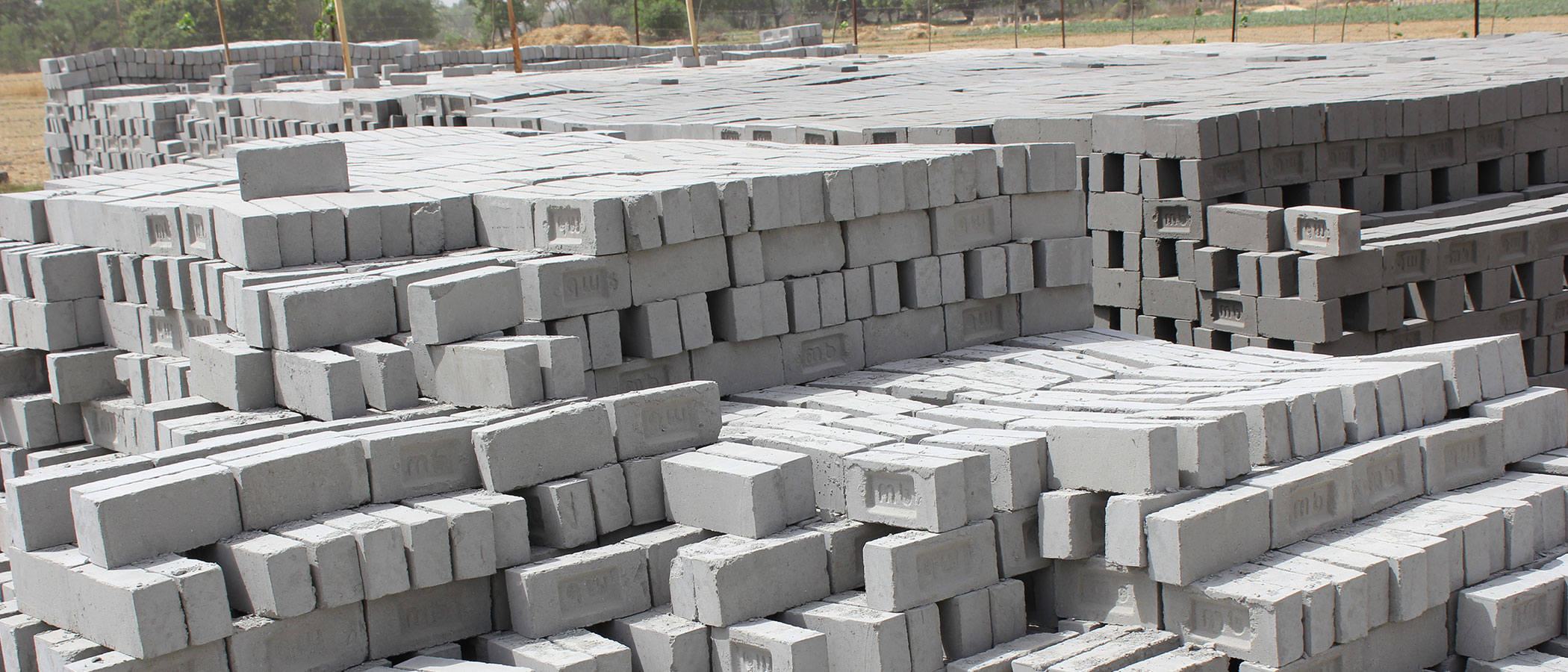Alternative Cement
Conventional cement production is a significant source of carbon dioxide. Reformulation can reduce emissions by millions of metric tons each year.
Reduced/Sequestered
2020–2050
To Implement
Impact
Cement is the second-most-used substance in the world after water, and cement production is a significant source of greenhouse gas emissions. Substituting materials such as volcanic ash, certain clays, finely ground limestone, ground bottle glass, or industrial waste products for conventional inputs can reduce the carbon footprint of cement by 7.70 to 15.56 gigatons between 2020 and 2050.
Introduction
Cement, the second-most-used substance in the world after water, is the source of significant greenhouse gas emissions. In 2016 alone, 1.46 gigatons of carbon dioxide were released as a result of cement production (Andrew, 2018).
To make portland cement, the most common form, crushed limestone and aluminosilicate clay are roasted in a kiln, producing calcium oxide (the desired product) and carbon dioxide (the waste). This carbon dioxide comprises roughly 60 percent of cement’s emissions. The rest results from energy use.
Project Drawdown’s Alternative Cement solution consists of making clinker, an intermediate product in the portland cement–making process, more efficiently and reducing the ratio of clinker to cement. To quantify the impact of the Alternative Cement solution, we collected demand forecasts from various global projections.
Adoption of the solution consists of two changes: reducing clinker intensity and improving the thermal and electricity intensity of production. Clinker intensity can be reduced by replacing portland cement with alternative materials that produce lower carbon dioxide emissions. Such alternative materials include industrial waste products such as fly ash from burning coal and slag from manufacturing iron, in addition to naturally occurring materials such as natural pozzolans, calcined clays, and limestone. Thermal and electricity intensity of clinker production can be reduced by upgrading cement kilns to modern standards, such as the use of pre-calciners and dry-kiln technologies.
Clinker substitution alone could avoid up to 440 million metric tons of carbon dioxide emissions annually. Establishment of standards, increased demand, and availability of clinker substitutes will be key for realizing the opportunity of alternative cements.
Methodology
To estimate the impact of adopting the Alternative Cement solution, we developed a set of scenarios for low-clinker cement in the context of international cement standards (ASTM and CEM). We then compared these scenarios with a reference scenario that fixed the adoption of low-clinker cement at its current percentage of the market. Finally, we estimated emissions and financial impacts by using a set of climate and financial variables to describe the relative emissions and costs of ordinary portland cement and low-clinker cement.
We modeled fly ash availability based on supply and demand data for coal production between 2020 and 2050. The supply of other clinker-replacement materials, such as calcined clays and limestone, largely outweighs the future demand for cement, so the supply of clinker replacements did not bound the model.
Total Addressable Market
In 2018 the global cement market was about 4.06 billion metric tons per year with an average clinker-to-cement ratio of 0.69. Alternative cement had a 31 percent share of the cement market. We estimated that the global cement market would be 4.15 billion metric tons per year in 2050. We based this estimate on estimates from the International Energy Agency and IIASA, in addition to forecasts from peer-reviewed literature.
Adoption Scenarios
We based our scenarios on average total global adoption of alternative cements. We estimated that 100 percent of the total addressable market’s clinker-to-cement ratio would decrease from 0.69 in 2018 to 0.46–0.61 by 2050. We based the varying clinker-to-cement ratio on the global cement industry’s current cement standards. We calculated impacts of increased adoption of the Alternative Cement solution from 2020 to 2050 by comparing two growth scenarios with the reference scenario.
- Scenario 1: Adoption reaches 4.01 billion metric tons of cement (100% of the total addressable market).
- Scenario 2: Adoption reaches 4.01 billion metric tons of cement (100% of the total addressable market).
Financial Model
Cost data were collected from cement suppliers and peer-reviewed literature, and all monetary values are presented in 2014 US$.
Results
Scenario 1 mitigates 7.70 gigatons of carbon dioxide equivalent emissions from 2020 to 2050. The marginal first benefit of implementing this solution is US$61.38 billion, and the lifetime saving is US$0.
Scenario 2 mitigates 15.56 gigatons of carbon dioxide equivalent emissions over the same period. The marginal first benefit of implementing this solution is US$61.38 billion, and the lifetime saving is US$0.
Discussion
We considered a variety of materials that can reduce the clinker-to-cement ratio is based on international standards of cement production and including cement types CEM II–CEM V. CEM III and CEM IV are typically used in specialty applications and were weighted according to base-year adoption levels (combined to be about 10 percent). CEM II and CEM V see increased adoption to nearly 90 percent of the market, displacing all market share of CEM I (traditional ordinary portland cement [OPC] system) in 2050 in both scenarios. Because the model is not limited by the availability of alternative binding materials, high adoption of the solution is feasible. We expect fly ash and slag supply to diminish as coal power and virgin steel production decreases. Other alternative materials, such as calcined clays, limestone, and natural pozzolanic materials, will replace fly ash and slag.
The gradual reabsorption of carbon dioxide by cementitious materials has the potential to recover up to 17 percent of their initial manufacturing emissions (Souto-Martinez et al., 2018). Due to the pervasiveness of concrete as a construction material around the world, we estimated that nearly 18.5 gigatons of carbon dioxide emissions were sequestered by reabsorption over 1930–2013, thereby reducing the net greenhouse impact of cement (Xi et al., 2016). Our analysis does not account for this carbonation, since the carbon uptake of existing concrete will occur regardless of the adoption of alternative cements. Alternative cements do not have the same ability as traditional OPC to sequester carbon dioxide due to different chemistries.
Vulnerability of concrete structures to the corrosive effects of global warming and sea level rise (Mithun Saha & Eckelman, 2014) might create more demand for cement in the coming decades; this, too, was not considered in the reference or adoption scenarios.
References
Andrew, R. M. (2018). Global CO2 emissions from cement production. Earth System Science Data, 10 pp. 195-217. DOI: https://doi.org/10.5194/essd-10-195-2018
Mithun Saha, M., Eckelman, M. J. (2014). Urban scale mapping of concrete degradation from projected climate change. Urban Climate, 9 pp. 101-114. DOI: https://doi.org/10.1016/j.uclim.2014.07.007
Souto-Martinez, A., Arehart, J. H., Srubar, W. V. (2018). Cradle-to-gate CO2e emissions vs. in situ CO2 sequestration of structural concrete elements. Energy and Buildings, 167 pp 301-311. DOI: 10.1016/j.enbuild.2018.02.042
Xi, F., Davis, S. J., Ciais, P., Crawford-Brown, D., Guan, D., Pade, C., Shi, T., Syddall, M., Lv, J., Ji, L., Bing, L., Wang, J., Wei, W., Yang, K., Lagerblad, B., Galan, I., Andrade, C., Zhang, Y., Liu, Z. (2016). Substantial global carbon uptake by cement carbonation. Nature Geoscience, 9 (12), 880-883. DOI: 10.1038/ngeo2840
What You Can Do
Boost visibility of the climate problems and solutions associated with cement by sharing this link with developers and contractors in your community.
Consider using alternatives to cement in your own construction projects.
- Expand your knowledge by exploring another Drawdown solution.
Co-benefits
Reducing emissions from the production and transport of cement has the co-benefits of reducing risks of extreme climate events, reducing air pollution, and improving mental health.
Improved air and water quality contribute to reduced respiratory and gastrointestinal illness.










